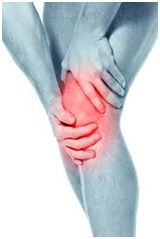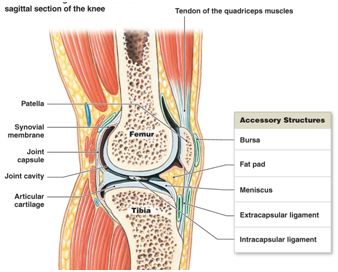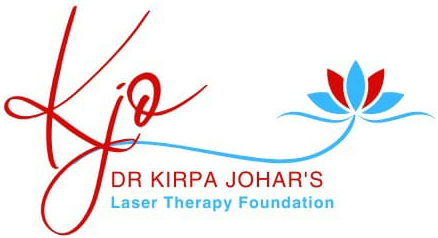Knee Pain
Most people have had a minor knee problem at one time or another. Most of the time our body movements do not cause problems, but it’s not surprising that symptoms develop from everyday wear and tear, overuse, or injury. Knee problems and injuries most often occur during sports or recreational activities, work-related tasks, or home project.
The knee is the largest joint in the body. The upper and lower bones of the knee are separated by two discs (menisci). The upper leg bone (femur) and the lower leg bones (tibia and fibula) are connected by ligaments, tendons, and muscles. The surface of the bones inside the knee joint is covered by articular cartilage, which absorbs shock and provides a smooth, gliding surface for joint movement. See a picture of the structures of the knee.


Although a knee problem is often caused by an injury to one or more of these structures, it may have another cause. Some people are more likely to develop knee problems than others. Many jobs, sports and recreation activities, getting older, or having a disease such as osteoporosis or arthritis increase your chances of having problems with your knees.
Causes of Knee Pain
1. Sudden (acute) Injuries
Injuries are the most common cause of knee problems. Sudden (acute) injuries may be caused by a direct blow to the knee or from abnormal twisting, bending the knee, or falling on the knee. Acute injuries include:
- Sprains, strains, or other injuries to the ligaments and tendons that connect and support the kneecap.
- A tear in the rubbery cushions of the knee joint (meniscus).
- Ligament tears, such as the anterior cruciate ligament (ACL). The medial collateral ligament (MCL) is the most commonly injured ligament of the knee.
- Breaks (fractures) of the kneecap, lower portion of the femur, or upper part of the tibia or fibula.
- Knee fractures are most commonly caused by abnormal force, such as a falling on the knee, a severe twisting motion, severe force that bends the knee, or when the knee forcefully hits an object.
- Kneecap dislocation
- Knee joint dislocation.
2. Overuse Injuries
Overuse injuries occur with repetitive activities or repeated or prolonged pressure on the knee. Activities such as stair climbing, bicycle riding, jogging, or jumping stress joints and other tissues and can lead to irritation and inflammation. Overuse injuries include:
- Knee bursitis
- Tendonitis
- Plica syndrome
- Patellofemoral pain syndrome
- Iliotibial band syndrome
3. Other Conditions That May Cause Knee Pain
Problems not directly related to an injury or overuse may occur in or around the knee.
- Osteoarthritis
- Osgood-Schlatter Disease
- A popliteal (or Baker’s) cyst
- A Problem Elsewhere in the body, such as a pinched nerve or a problem in the hip can sometimes cause knee pain.
- Osteochondritis dissecans
Symptoms of Knee Pain
The location and severity of knee pain may vary, depending on the cause of the problem. Signs and symptoms that sometimes accompany knee pain include:
- Swelling and stiffness
- Redness and warmth to the touch
- Weakness or instability
- Popping or crunching noises
- Inability to fully straighten the knee
Diagnosis of Knee Pain
The following tests may be done:
- Joint fluid culture (fluid taken from the knee and examined under a microscope)
- MRI of the knee if a ligament or meniscus tear is suspected
- X-ray of the knee
Treatment
Treatments will vary, depending upon what exactly is causing your knee pain.
Medications
Your doctor may prescribe medications to help relieve pain and to treat underlying conditions, such as rheumatoid arthritis or gout.
Therapy
Strengthening the muscles around your knee will make it more stable. Exercises to improve your balance are also important. In certain conditions, different types of braces may be used to help protect and support the knee joint.
Injections
In some cases, your doctor may suggest injecting medications directly into your joint. Examples include: Corticosteroids and Supplemental lubrication
Surgery
If you have an injury that may require surgery, it’s usually not necessary to have the operation immediately. Before making any decision, consider the pros and cons of both nonsurgical rehabilitation and surgical reconstruction in relation to what’s most important to you. Surgical treatment includes: Arthroscopic surgery, Partial knee replacement surgery, total knee replacement surgery.
Low Level Laser Therapy Treatment for Knee Pain
Low Level Laser Therapy (LLLT) is the application of red and near infrared light over injuries to stimulate cellular repair. LLLT has a powerful anti-inflammatory effect as well as a healing effect on the inflamed tendons of knee and surrounding inflamed soft tissues.
By improving circulation and increasing cellular repair functions LLLT provides an environment for your body’s own natural healing processes to be activated and restored.
LLLT stimulates blood flow and lymphatic drainage, improved delivery of O2 and nutrition to the area, oxygen utilization, removal of oxygen-free radicals and other waste products, and tissue healing.
You will be encouraged to move the affected area within range of movement/pain but not exert stretch or force during the healing phase. The end result is resolution of inflammation and restoration of healthy tendons and local soft tissues. Once tissues are healed, pain is eliminated and normal range of motion and function is restored. Then muscle and tendon strength and flexibility can be addressed with graduated exercises and stretching.
LLLT has no known side effects, is safe and effective.
